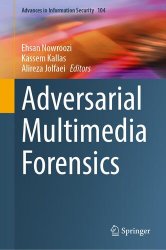Adversarial Multimedia Forensics
- Добавил: literator
- Дата: 6-03-2024, 07:34
- Комментариев: 0
 Название: Adversarial Multimedia Forensics
Название: Adversarial Multimedia ForensicsАвтор: Ehsan Nowroozi, Kassem Kallas, Alireza Jolfaei
Издательство: Springer
Серия: Advances in Information Security
Год: 2024
Страниц: 298
Язык: английский
Формат: pdf (true), epub
Размер: 45.9 MB
This book explores various aspects of digital forensics, security and Machine Learning, while offering valuable insights into the ever-evolving landscape of multimedia forensics and data security. This book’s content can be summarized in two main areas. The first area of this book primarily addresses techniques and methodologies related to digital image forensics. It discusses advanced techniques for image manipulation detection, including the use of Deep Learning architectures to generate and manipulate synthetic satellite images. This book also explores methods for face recognition under adverse conditions and the importance of forensics in criminal investigations. Additionally, the book highlights anti-forensic measures applied to photos and videos, focusing on their effectiveness and trade-offs.
Sophisticated editing software and Deep Learning have facilitated the creation of convincing forgeries. Deepfakes can seamlessly swap faces, making it appear that people said or did things that they did not. Audio spoofing can frauduently replicate voice recording. These manipulations cause harm from personal defamation to the spread of societal-scale misinformation. Traditional forensic methods look for inconsistencies in lighting or pixels in order to detect forgeries. However, advanced manipulation techniques have been used to evade these mechanisms. This creates an adversarial cat-and-mouse dynamic, in which analysts must constantly adapt. This book explores how adversarial Machine Learning can help and challenge forensic efforts. Readers will dive deeply into techniques from classic signal processing to cutting-edge Machine Learning used in adversarial multimedia forensics. Topics such as feature extraction, anomaly detection, and adversarial training were covered, providing balanced perspectives on the strengths and limits of the approaches. The case studies offer insights into real-world applications. As manipulation continues to evolve, this field must also evolve. The book concludes by looking at future directions, such as integrating metadata, developing real-time systems, and creating standardized benchmarks to evaluate methods.
While numerous forensic techniques have been proposed to establish information authenticity, the advancement of Artificial Intelligence (AI) technologies created new opportunities for adversaries. Specifically, AI models allow to create high-quality deep fakes and remove traces of data tampering to get around existing validation methods. Referred to as anti-forensics, these techniques pose a significant threat to traditional forensics. The majority of multimedia forensic approaches operate by identifying distinct patterns or traces left by algorithms used to create and modify digital data. These techniques can be further classified into two categories based on whether the examiner applies analytical tools or Deep Learning (DL) algorithms. Recent examples of incorporating ML and DL algorithms into the tools for digital forensics demonstrate their high potential and benefit for investigation procedures. While DL-based models are proven to be highly successful in detecting multimedia alterations compared to traditional analytical methods, they come with multiple design complexities. First, the system requires a large amount of relevant data which has to be both diversified yet homogeneous such that an algorithm can learn to generalize correct patterns. Next, the model needs to be developed and trained via multiple iterations, which requires the availability of high-power computing resources and time.
Intended for those in Computer Science, engineering, and other related fields, this book explores the challenges and opportunities of the adversarial side of multimedia forensics. Some Machine Learning and signal processing basics are helpful but are not required. The goal is to equip readers with the knowledge to navigate this complex space and drive innovation in this exciting, ever-changing field.
Contents:
Скачать Adversarial Multimedia Forensics
Внимание
Уважаемый посетитель, Вы зашли на сайт как незарегистрированный пользователь.
Мы рекомендуем Вам зарегистрироваться либо войти на сайт под своим именем.
Уважаемый посетитель, Вы зашли на сайт как незарегистрированный пользователь.
Мы рекомендуем Вам зарегистрироваться либо войти на сайт под своим именем.
Информация
Посетители, находящиеся в группе Гости, не могут оставлять комментарии к данной публикации.
Посетители, находящиеся в группе Гости, не могут оставлять комментарии к данной публикации.

